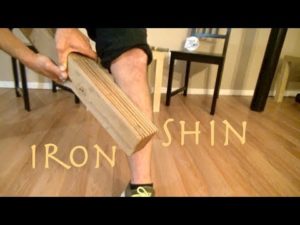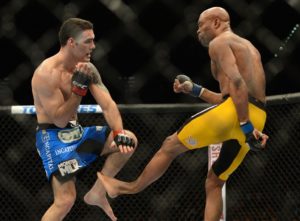LSJL is lateral loading of the synovial joints or possible the epiphysis of the bone to stimulate fluid flow to stimulate degradation(remodeling) of the cortical bone and creation of mesenchymal stem cell chondrogenesis through a favorable microenvironment.
Martial arts bone condition is another form of this as impact is a form of loading. However impact loading would not stimulate the soft tissues surrounding the bone which are all connected to the bone this is an important distinction. Axial loading does not really drive fluid flow so that elements punching as a studiable stimulus. However, several martial artists do tapping of the bones of the leg and arm.
The different between this and an LSJL style tapping would be that the tapping would not necessarily be at the longitudinal ends of the bone so the bone would be more innervated and there would be less of a fluid pressure gradient than at the longitudinal ends of the bone. The goal of martial arts bone conditioning is described as something like calcification or bone thickening which is not exactly what we want.
The other difference between LSJL and martial arts bone conditioning is the intensity of the load. Short intense bursts is more osteogenic whereas longer less intense bursts of loading are more chondrogenic. This is primarily because osteocytes respond to sudden changes in fluid flow but osteocytes(probably) cannot make you taller as osteocytes produce bone and bone is what blocks you from growing taller! Soft tissue is what allows for interstitial growth. So for LSJL style loading you would tap the longitudinal ends of the bone with more frequency and less intensity.
If the bones weren’t so innervated would you be able to grow via martial arts style loading? Probably not by rolling a bottle up and down your leg. But we know that martial artists fracture legs during kicks.
And fractures definitely result in longitudinal bone growth because the bone clot results in a lot of fluid stimulus and it removes the cortical bone impediment.
We also know that there’s a phenomenon known as stress fractures where bones can develop fracture over time to non-overly traumatic loads just as the bone is no longer able to recover.
But we want to know if it’s possible to induce the longitudinal bone growth stimulus without fracturing a bone. And could it be possible with a tapping stimulus? The key is to target a less innervated part of the bone which happens to be the epiphysis although there are some epiphysis where regions are fairly innervated. Tapping the epiphysis also generates a fluid pressure gradient.
With these fluid pressures we want to stimulate bone degradation via osteoclasts(remodeling)[this process could be accelerated via HGH] but we don’t want bone deposition via osteocytes and osteoblasts we want cartilage deposition although it’s feasible that other fibrocartilage tissues could work so that’s why we want sustained loading pressures over time so consistent taps. The stress fracture phenomenon is also beneficial for our purposes. Microcracks are good at stimulating fluid forces.
Nerve issues are probably unavoidable but we want to choose the least nerved location.
Does anyone have any anecdotal evidence of martial artist effects on bone?
I know there’s not a lot of solid proof of anything here but basically I’m testing epiphyseal tapping over prolonged periods to generate bone degradation and creating a favorable microenvironment for replacement via soft tissues. I wanted people to know what I’m working on as I haven’t posted here in a while. I’m solely dependent on generating proof at this point so if anyone has any evidence of martial artists generating any kind of visible bone adaptation whatsoever that would be extremely helpful.


